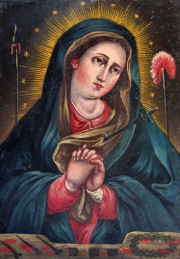Highlights

Prayer of the Month
Prayer of St. Bonaventure
Lady, who by thy sweetness dost ravish the hearts of men, hast thou not ravished mine? O ravisher of hearts, when wilt thou restore me mine? Rule and govern it like thine own; preserve it in the Blood of the Lamb, and place it in thy Son’s side. Then shall I obtain what I desire, and possess what I hope for; for thou art our hope.
The month of the Seven Sorrows of Mary
The Catholic Church dedicates September to the Seven Sorrows of Mary. A devotion dating from the twelfth century, when, under the influence of St. Anselm and St. Bernard., it made its appearance in monastic circles. It was the Cistercians and then the Servites that went on to propagate it. In the fourteenth century, it became widespread, and then in the fifteenth century, it flourished in the Rhineland and in Flanders, where Confraternities of the Sorrowful Mother sprang up. In this context, the first liturgical formularies in her honour were composed. A provincial council of Mainz in 1423 made use of these in establishing a “Feast of the Sorrows of Mary” in reparation for Hussite profanations of her images.
Arriving in in Bruges, in In 1494, where the Precious Blood of Christ was venerated; later it made its way into France. However, it did not become widespread in France before Benedict XIII included it in the Roman Calendar in 17,27 and assigned it to the Friday before Palm Sunday.
Some Churches had previously celebrated this feast during the Easter season. Others, however, celebrated the Joys of the Blessed Virgin during the Easter season, as is still done today at Braga. In some places, it was entitled “Recollection of the Feasts and Joys of the Blessed Virgin Mary.”
Excerpted from The Church at Prayer, Vol. IV A.G. Martimort. (Paraphrased)
Fr. Faber on the Seven Sorrows

God consented to select the things about Him that were most indescribable, and in a most mysteriously unquestionable way communicate them to Mary. See how He had already combined her up with the eternal designs of creation, making her almost a partial cause and partial model of it. Our Lady’s collaboration in the salvation of the world gives us a fresh view of her splendour. Neither the Immaculate Conception nor the Assumption will give us a higher idea of Mary’s Creation exaltation than the title of co-redemptress. Her sorrows were not necessary for the world’s redemption, but in God’s counsel, they were indivisible from it. They belong to the integrity of the divine plan. Are not Mary’s mysteries Jesus’ mysteries, and His mysteries hers? The truth appears to be that all the mysteries of Jesus and Mary were in God’s design as one mystery. Jesus, Himself was Mary’s sorrow, seven times repeated, aggravated sevenfold. During the hours of the Passion, the offering of Jesus and the offering of Mary were combined in one. (Father Faber Paraphrased see Fr. Faber on the 7 Sorrows )
Documents
The Seven Dolors of Our Lady by St. Alphonsus Ligouri
Websites

